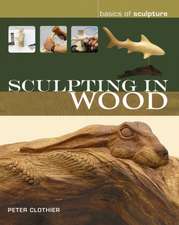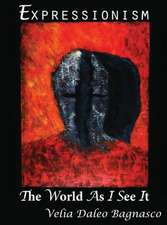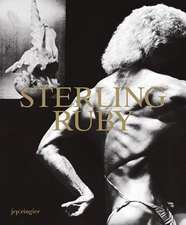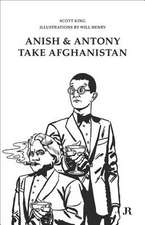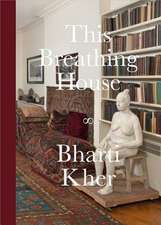David Hockney: Modern Masters Series
Autor Peter Clothieren Limba Engleză Paperback – 28 feb 1995
For a contemporary artist of serious aesthetic purpose, David Hockney enjoys immense, perhaps unequaled public visibility: the shock of dyed blond hair, the owlish glasses, and the shy, schoolboy grin are known as much through the popular press as through the journals of the art world. His engaging personality, his quirky but always enlightening ideas about art, and his inexhaustible inventiveness both of imagery and of techniques ranging from oil painting to photography to faxes are captured by Peter Clothier with clear-eyed intelligence and grace in this concise but comprehensive overview.
From his theatrical early canvases to his more recent photographic collages and operatic set designs, Hockney has tackled the challenge of space on a grand scale. At the same time, much of his work has been devoted to the things most dear to him-friends, family, home, and studio. An intellectual of wide-ranging erudition and a world traveler who makes his home in Hollywood, he still cherishes his roots in Bradford, the northern British town where he was born in 1937.
Invention, the driving force behind Hockney's art, is in good part play: "If art isn't playful," he once commented, "it's nothing." This illuminating, color-rich volume conveys with vivid clarity Hockney's serious delight in making art that gives pleasure to both its creator and its audience.
About the Modern Masters series:
With informative, enjoyable texts and over 100 illustrations—approximately 48 in full color—this innovative series offers a fresh look at the most creative and influential artists of the postwar era. The authors are highly respected art historians and critics chosen for their ability to think clearly and write well. Each handsomely designed volume presents a thorough survey of the artist's life and work, as well as statements by the artist, an illustrated chapter on technique, a chronology, lists of exhibitions and public collections, an annotated bibliography, and an index. Every art lover, from the casual museumgoer to the serious student, teacher, critic, or curator, will be eager to collect these Modern Masters. And with such a low price, they can afford to collect them all.
From his theatrical early canvases to his more recent photographic collages and operatic set designs, Hockney has tackled the challenge of space on a grand scale. At the same time, much of his work has been devoted to the things most dear to him-friends, family, home, and studio. An intellectual of wide-ranging erudition and a world traveler who makes his home in Hollywood, he still cherishes his roots in Bradford, the northern British town where he was born in 1937.
Invention, the driving force behind Hockney's art, is in good part play: "If art isn't playful," he once commented, "it's nothing." This illuminating, color-rich volume conveys with vivid clarity Hockney's serious delight in making art that gives pleasure to both its creator and its audience.
About the Modern Masters series:
With informative, enjoyable texts and over 100 illustrations—approximately 48 in full color—this innovative series offers a fresh look at the most creative and influential artists of the postwar era. The authors are highly respected art historians and critics chosen for their ability to think clearly and write well. Each handsomely designed volume presents a thorough survey of the artist's life and work, as well as statements by the artist, an illustrated chapter on technique, a chronology, lists of exhibitions and public collections, an annotated bibliography, and an index. Every art lover, from the casual museumgoer to the serious student, teacher, critic, or curator, will be eager to collect these Modern Masters. And with such a low price, they can afford to collect them all.
Preț: 125.22 lei
Nou
Puncte Express: 188
Preț estimativ în valută:
23.96€ • 25.62$ • 19.98£
23.96€ • 25.62$ • 19.98£
Carte disponibilă
Livrare economică 27 martie-10 aprilie
Livrare express 12-18 martie pentru 36.14 lei
Preluare comenzi: 021 569.72.76
Specificații
ISBN-13: 9780789200365
ISBN-10: 0789200368
Pagini: 128
Ilustrații: colour and b&w illustrations, portraits
Dimensiuni: 216 x 279 x 15 mm
Greutate: 0.64 kg
Ediția:New.
Editura: Abbeville Publishing Group
Colecția Abbeville Press
Seria Modern Masters Series
Locul publicării:United States
ISBN-10: 0789200368
Pagini: 128
Ilustrații: colour and b&w illustrations, portraits
Dimensiuni: 216 x 279 x 15 mm
Greutate: 0.64 kg
Ediția:New.
Editura: Abbeville Publishing Group
Colecția Abbeville Press
Seria Modern Masters Series
Locul publicării:United States
Cuprins
Introduction 7
Early Days 11
Toward Naturalism 25
Out of the Trap 43
Explorations in Space 65
Turning Inward 83
Notes 101
Artists’ Statements 103
Notes on Technique 109
Chronology 115
Exhibitions 119
Public Collections 122
Selected Bibliography 123
Index 126
Early Days 11
Toward Naturalism 25
Out of the Trap 43
Explorations in Space 65
Turning Inward 83
Notes 101
Artists’ Statements 103
Notes on Technique 109
Chronology 115
Exhibitions 119
Public Collections 122
Selected Bibliography 123
Index 126
Notă biografică
Peter Clothier — like Hockney a British expatriate living in Southern California — is a novelist, art critic, and lecturer. His previous writings include two novels — Dirty-Down and Chiaroscuro — plus two books of poetry and numerous articles and art reviews.
Extras
INTRODUCTION
For the contemporary artist of serious aesthetic purpose, David Hockney enjoys immense, perhaps unequaled public visibility: the shock of dyed blond hair, the owlish glasses, and the shy schoolboy grin are known as much through the popular press as through the journals of the art world. His renown results in part from his early emergence as the enfant terrible of contemporary British painting, photographed by Lord Snowdon for the Sunday Times in the flamboyant gold lame jacket in which he opted to receive his medal for “work of outstanding distinction” as he graduated from the Royal College of Art in 1962. This was the time, too, when London was the swinging capital of the new jet set, and the high-spirited antics of youngsters like the Beatles and the Rolling Stones had rocketed their country to the vanguard of international popular culture. It was an ideal context for Hockney’s disarming openness, for the cheerful disrespect for convention that characterized his life and work, and for the zest with which he embraced his growing fame.
Yet behind the eccentric individualist who appeared so eager for success lurked a relatively shy and introspective artist, whose determination can be gauged by the injunction that he painted in careful Roman lettering on the chest of drawers by the bed in his first London studio: “Get up and work immediately.” This dual spirit of play and stubborn dedication has continued to determine both his chosen path in life and the nature of his work. A celebrity and world traveler who makes his home in Hollywood, he continues to cherish his roots in Bradford, the northern British town where he was born in 1937 to a “radical working-class family.” An intellectual of wide-ranging erudition and culture, he still speaks with the blunt, unabashed simplicity of a Yorkshireman. He reveres the parents whose qualities he blends: his mother, Laura, a Methodist and a vegetarian, a woman of unstinting dedication to the work of keeping a brood of four sons and one daughter in strict but loving order; and his father, Kenneth, a true British eccentric who penned protest letters on political issues to world leaders like Stalin and Mao. “He taught me,” Hockney said, “not to care what the neighbors think.” Kenneth’s fascination with technology—from clocks and watches to the collection of battered, Scotch-taped cameras he would wear around his neck—was perhaps the source of Hockney’s own continuing obsession with invention and the latest high-tech gear.
It may seem a contradiction that this son of the gloomy north eventually produced those pictures for which he is best known, images of the brilliant light and the good life of Southern California. Paintings like A Bigger Splash (1967)—and the movie that borrowed its name—created a bigger splash than Hockney may have expected, generating an unwanted stereotype from which he found it hard to separate. The popular appeal of these paintings also placed a weapon in the hands of detractors who mistrusted their beauty, their extraordinary facility with line and color, and their delight in depiction at a historical moment when representational painting had been declared retrograde by a powerful critical elite. Yet for Hockney, in the words of his friend Henry Geldzahler, “Art from the first has been the need to communicate directly with the viewer. [He] is not at all involved in the creation of beauty as an end in itself. It is exactly this urgency, this need to be heard plainly and to be understood clearly, which is the basis for his phenomenal popularity.
Hockney’s vision ranges from the grandiose to the intimate, often embracing both at the same time. From early paintings of theatrical intention and scope like A Grand Procession of Dignitaries in the Semi-Egyptian Style to photo collages of the Grand Canyon and his recent operatic set designs, he has engaged the challenge of space on a massive scale. At the same time, a great body of his work is devoted to things most close and dear to him—friends, family, home, and studio. To come to know his work is to learn to recognize those faces that recur everywhere in paintings, drawings, photo collages, graphic works, and snapshots: his mother, Henry Geldzahler, and his friend and frequent model Celia Birtwell, among many others. Prominent in this personal gallery are the faces and sensuous bodies of the young men he has admired and loved, seen through his eyes in all their erotic beauty.
The human body has been central to Hockney’s art, most obviously as its subject. But painting has also meant physical action for him. As a child he watched his father refurbish old bicycles with a coat of paint and “modernize” the family house by decorating all the doors with sunsets, and he felt “the fascination of the brush dripping in paint, putting it on, I loved that even then, I love it now.” He has become increasingly aware in recent years that the love of Cubism derives from his sense that it was “about our bodily presence in the world…It’s ultimately about where we are in it, how we are in it.” His idea of representation is not to reflect back images of the external world—those “naturalist” images that, he has argued frequently, the photographic process has deceived us into accepting as reality—but to re-create the process of our seeing, to invent in art a world in which we experience the visceral reality of space and time, physical substance, change, and movement.
Invention, the driving force behind his art, is in good part play: “If art isn’t playful,” he once commented, “it’s nothing.” In part, too, it is the unfailing spirit of curiosity and exploration. “Hockney is the kind of artist,” one critic noted, “who, upon encountering a question in his work, no matter how small or seemingly insignificant, will follow the path that opens up until he feels comfortable with the new terrain.” Alarming to those who are more comfortable with clear progression and continuity, this quality has contributed to Hockney’s separation from the mainstream of contemporary art. It is also the asset that he himself prizes most.
For the contemporary artist of serious aesthetic purpose, David Hockney enjoys immense, perhaps unequaled public visibility: the shock of dyed blond hair, the owlish glasses, and the shy schoolboy grin are known as much through the popular press as through the journals of the art world. His renown results in part from his early emergence as the enfant terrible of contemporary British painting, photographed by Lord Snowdon for the Sunday Times in the flamboyant gold lame jacket in which he opted to receive his medal for “work of outstanding distinction” as he graduated from the Royal College of Art in 1962. This was the time, too, when London was the swinging capital of the new jet set, and the high-spirited antics of youngsters like the Beatles and the Rolling Stones had rocketed their country to the vanguard of international popular culture. It was an ideal context for Hockney’s disarming openness, for the cheerful disrespect for convention that characterized his life and work, and for the zest with which he embraced his growing fame.
Yet behind the eccentric individualist who appeared so eager for success lurked a relatively shy and introspective artist, whose determination can be gauged by the injunction that he painted in careful Roman lettering on the chest of drawers by the bed in his first London studio: “Get up and work immediately.” This dual spirit of play and stubborn dedication has continued to determine both his chosen path in life and the nature of his work. A celebrity and world traveler who makes his home in Hollywood, he continues to cherish his roots in Bradford, the northern British town where he was born in 1937 to a “radical working-class family.” An intellectual of wide-ranging erudition and culture, he still speaks with the blunt, unabashed simplicity of a Yorkshireman. He reveres the parents whose qualities he blends: his mother, Laura, a Methodist and a vegetarian, a woman of unstinting dedication to the work of keeping a brood of four sons and one daughter in strict but loving order; and his father, Kenneth, a true British eccentric who penned protest letters on political issues to world leaders like Stalin and Mao. “He taught me,” Hockney said, “not to care what the neighbors think.” Kenneth’s fascination with technology—from clocks and watches to the collection of battered, Scotch-taped cameras he would wear around his neck—was perhaps the source of Hockney’s own continuing obsession with invention and the latest high-tech gear.
It may seem a contradiction that this son of the gloomy north eventually produced those pictures for which he is best known, images of the brilliant light and the good life of Southern California. Paintings like A Bigger Splash (1967)—and the movie that borrowed its name—created a bigger splash than Hockney may have expected, generating an unwanted stereotype from which he found it hard to separate. The popular appeal of these paintings also placed a weapon in the hands of detractors who mistrusted their beauty, their extraordinary facility with line and color, and their delight in depiction at a historical moment when representational painting had been declared retrograde by a powerful critical elite. Yet for Hockney, in the words of his friend Henry Geldzahler, “Art from the first has been the need to communicate directly with the viewer. [He] is not at all involved in the creation of beauty as an end in itself. It is exactly this urgency, this need to be heard plainly and to be understood clearly, which is the basis for his phenomenal popularity.
Hockney’s vision ranges from the grandiose to the intimate, often embracing both at the same time. From early paintings of theatrical intention and scope like A Grand Procession of Dignitaries in the Semi-Egyptian Style to photo collages of the Grand Canyon and his recent operatic set designs, he has engaged the challenge of space on a massive scale. At the same time, a great body of his work is devoted to things most close and dear to him—friends, family, home, and studio. To come to know his work is to learn to recognize those faces that recur everywhere in paintings, drawings, photo collages, graphic works, and snapshots: his mother, Henry Geldzahler, and his friend and frequent model Celia Birtwell, among many others. Prominent in this personal gallery are the faces and sensuous bodies of the young men he has admired and loved, seen through his eyes in all their erotic beauty.
The human body has been central to Hockney’s art, most obviously as its subject. But painting has also meant physical action for him. As a child he watched his father refurbish old bicycles with a coat of paint and “modernize” the family house by decorating all the doors with sunsets, and he felt “the fascination of the brush dripping in paint, putting it on, I loved that even then, I love it now.” He has become increasingly aware in recent years that the love of Cubism derives from his sense that it was “about our bodily presence in the world…It’s ultimately about where we are in it, how we are in it.” His idea of representation is not to reflect back images of the external world—those “naturalist” images that, he has argued frequently, the photographic process has deceived us into accepting as reality—but to re-create the process of our seeing, to invent in art a world in which we experience the visceral reality of space and time, physical substance, change, and movement.
Invention, the driving force behind his art, is in good part play: “If art isn’t playful,” he once commented, “it’s nothing.” In part, too, it is the unfailing spirit of curiosity and exploration. “Hockney is the kind of artist,” one critic noted, “who, upon encountering a question in his work, no matter how small or seemingly insignificant, will follow the path that opens up until he feels comfortable with the new terrain.” Alarming to those who are more comfortable with clear progression and continuity, this quality has contributed to Hockney’s separation from the mainstream of contemporary art. It is also the asset that he himself prizes most.
Descriere
Hockney's engaging personality, his quirky but always enlightening ideas about art, and his inexhaustible inventiveness are captured with clear-eyed intelligence and grace in the newest volume in Abbeville's renowned Modern Master Series. Illustrations.





